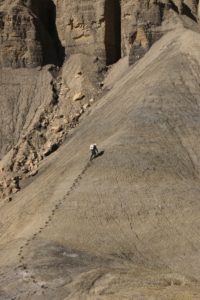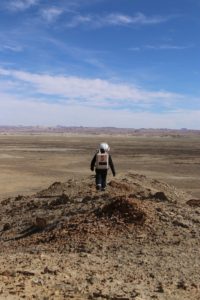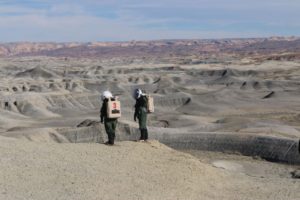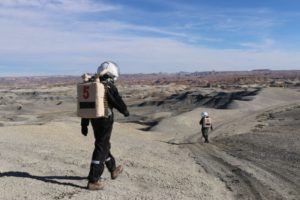EVA #17
Crew members (3) : Xavier Rixhon (EVA leader), Mouâdh Bouayad and Arthur Lillo (EVA buddies)
Location: Hab surroundings and South of the Hab (12N 518500, 4250000)
Vehicules : Rover Deimos and ATV 350 #3
Time : departure at 09:00 am and back at 10:02 am
Duration : 1 hour
Purposes:
• Understanding why the balloon flew away shortly after EVA#16
• Searching for balloon crash site and potentially retrieving the platform with the equipment
• Unburying the seismometer from its working place and bringing it back to the Hab
• Even if we take the radio switched ON with us, as soon as the engineering check is completed, we’ll try to complete all these tasks staying silent and using hands motion inspired by scuba diving
• Using AR glasses to record the different data collected during the EVA Engineering Check
Summary:
Before getting through the EVA summary itself, I’d like to say I’m pretty proud of my team. Indeed, we got into the main airlock, to start the depressurisation, right on time : 9:00 am sharp.
As explained in the EVA request, this EVA was one of the kind. As soon as we exited the main airlock after depressurisation, as the current leader, I indicated to my two fellow EVA buddies that the microphone of the radios were down. This marked the starting point of the “radios down” simulation. All along this one hour EVA, no word will have been said. The only way to make us understood by the others will have had to be hands gestures, mainly inspired by scuba diving. As expected, patience and calm would have been the key words of this EVA.
In a safety concern (we never left one man alone behind), we stayed together during the traditional pre-EVA engineering check. Guided by Victoria giving her instructions through the radio earpieces, we went around the Hab to collect the relevant data. As we couldn’t forward them straight away to Victoria, Arthur, wearing the AR glasses, used the voice recording functionality to record the different values and save them in sound files. Meanwhile, inside the Hab, Louis Maller was downloading these files on his personal computer to give the information to Victoria afterwards. Eventually, she could fill in the Engineering Checklist table (for Operations Report purposes). Furthermore, Louis tested the screen shot functionality. For instance, he screen shot what Arthur was seeing during the static tank water level check. This operation was a great success since the engineering check has never attempted this way. On one hand, we didn’t take that much time to complete the check. On the other hand, we took the opportunity to test the AR glasses as never before.
Once we were done with the engineering check, we headed to the site where the balloon had been attached yesterday before flying away. We found the stone anchor built up by EVA#16 team and the loose rope which was keeping the balloon on site. From the anchor, the rope headed South where the balloon maybe flew away. After understanding this, we walked around the anchor site though, hoping to find a torn apart balloon lying on the ground. Unfortunately, after few minutes, we figured out that our little friend was gone once and for all.
Back to the Hab, I gave the leadership to Arthur before he drove the ATV ahead of Mouâdh and I on the Rover Deimos. We headed to the seismometer site (South of the Hab). Once we got there, Arthur gave the leadership to Mouâdh who had already briefed us how to proceed to retrieve the seismometer : Arthur pulled up the battery and I took care of the seismometer while Mouâdh was unplugging the different wires and packing them up in the box with the acquisition system. Then, we put the equipment back in the rover before filling the hole which had been dug at Sol 5. After this task being completed, Mouâdh gave me the leadership back for the ride to the Hab. To end this EVA as it had started, we listened carefully to the final check instructions given by Victoria.
This short EVA was great : not only because we performed the task as expected but mainly because the messages between EVA participants was clear and efficient enough to make us spend only one hour outside to do everything. The rotating leadership worked perfectly and everyone took his role seriously. We came up with creative gestures so no doubts would remain in our communications.
In conclusion, despite the bulky life support system, the fog on the helmet glass and procedure (quite simple though) to follow, we managed to reach our objectives without speaking up at all. In other words, this means that a real radio failure doesn’t specially jeopardise an entire EVA if the participants are well prepared and briefed.






